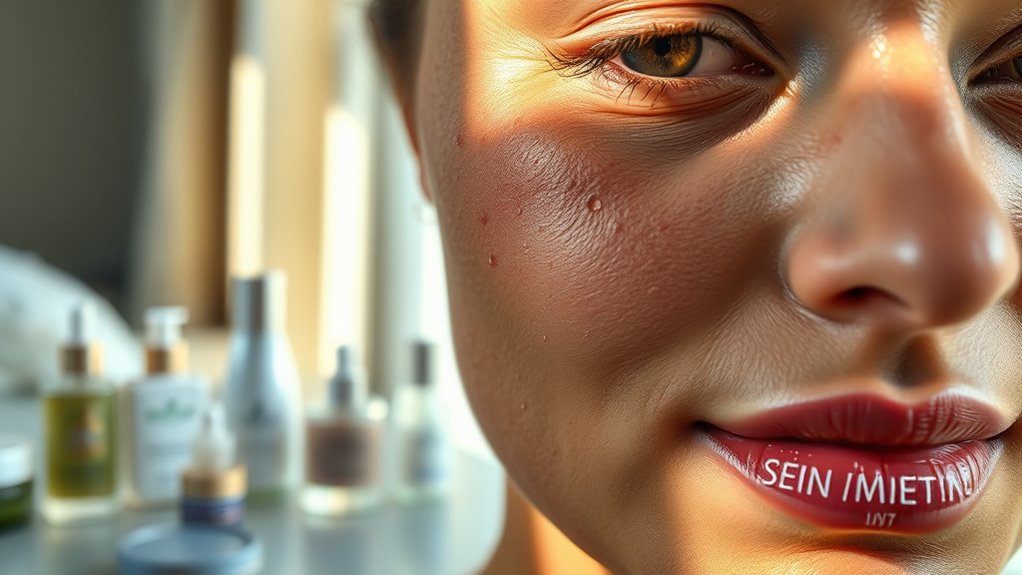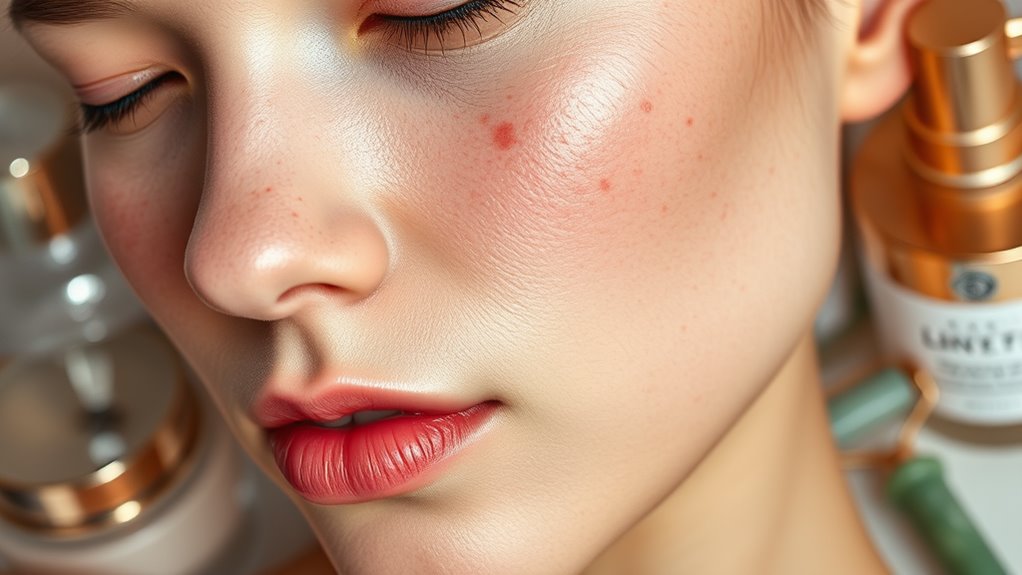Why Your Dark Spots Aren’t Fading – And What You Can Do
If your dark spots aren’t fading, it’s likely due to inconsistent product use, inadequate sun protection, or improper skincare routines that fail to promote cell turnover. Environmental factors and hormonal changes can also exacerbate melanin overproduction. Ensure you’re using a broad-spectrum sunscreen daily and incorporate effective treatments like retinoids or vitamin C. Consistency is key to achieving visible results. Discover more about common mistakes and effective strategies to tackle stubborn dark spots.
Key Takeaways
- Inconsistent use of topical treatments can prolong dark spots’ visibility; ensure regular application for optimal results.
- Skipping sunscreen allows existing dark spots to persist and new ones to form; use SPF 30 or higher daily.
- Incorrect product layering reduces absorption; apply skincare in the right order for maximum efficacy.
- Overusing harsh ingredients can irritate skin, triggering more melanin production; opt for gentle formulations.
- Professional evaluation may be necessary if dark spots persist despite home treatments; consult a dermatologist for personalized guidance.
Understanding the Causes of Dark Spots
While you might think dark spots only come from sun exposure, several factors contribute to their development.
Hormonal changes, particularly during pregnancy or from contraceptives, can trigger melasma, leading to dark spots not fading. Additionally, post-inflammatory hyperpigmentation results from injuries or acne, where the skin overproduces melanin during the healing process.
Environmental factors, like pollution, can also exacerbate pigmentation issues, as free radicals damage skin cells and accelerate melanin production.
Furthermore, genetic predisposition plays a significant role; if your family has a history of dark spots, you’re more susceptible.
Lastly, inadequate skincare routines lacking exfoliation or active ingredients may prevent proper skin cell turnover, leaving dark spots entrenched. Incorporating effective strategies for treatment and prevention is essential for achieving healthier skin.
Understanding these causes is crucial for effective treatment and prevention.
Common Mistakes in Skincare Routines
You might be unknowingly sabotaging your skincare efforts with common mistakes that hinder dark spot fading.
Skipping sun protection, using products inconsistently, and overapplying harsh ingredients can all contribute to a less effective routine. Understanding these pitfalls is crucial for achieving the clear, even skin you desire. Additionally, neglecting proper sun protection can exacerbate dark spots, making them even more difficult to fade.
Skipping Sun Protection
Although many people invest in an extensive skincare routine, neglecting sun protection can undermine all their efforts, particularly in fading dark spots. Ultraviolet (UV) rays stimulate melanin production, exacerbating hyperpigmentation. By skipping sunscreen, you allow existing dark spots to persist and new ones to form, counteracting your skincare investments.
| Consequences of Skipping Sun Protection | Benefits of Consistent Sun Protection |
|---|---|
| Increased melanin production | Reduces the risk of new dark spots |
| Prolonged healing time for existing spots | Enhances the effectiveness of other products |
| Heightened skin damage and aging | Promotes an even skin tone |
Incorporating a broad-spectrum SPF daily is essential for anyone serious about achieving luminous, clear skin. Don’t underestimate this vital step.
Inconsistent Product Usage
Inconsistent product usage often undermines the effectiveness of your skincare routine, leading to prolonged visibility of dark spots. To achieve optimal results, you must commit to a consistent regimen.
Here are three crucial aspects to consider:
-
Daily Application: Ensure you’re applying your active ingredients, like vitamin C or retinoids, daily. Skipping days can interrupt skin cell turnover and hinder fading.
-
Correct Dosage: Using too little product won’t deliver the desired effects. Follow recommended amounts to ensure effective penetration and action.
-
Layering Order: Apply products in the right sequence to maximize absorption. Start with thinnest to thickest to enhance the efficacy of each ingredient.
Overusing Harsh Ingredients
When harsh ingredients are overused, they can wreak havoc on your skin, exacerbating dark spots instead of fading them. Ingredients like retinoids, alpha hydroxy acids (AHAs), and benzoyl peroxide can disrupt your skin’s natural barrier when applied excessively.
This disruption leads to increased inflammation and irritation, which may trigger more melanin production, darkening existing spots. Additionally, over-exfoliation can strip away protective oils, leaving your skin vulnerable and reactive.
To achieve mastery in your skincare routine, prioritize balance. Introduce potent ingredients gradually and allow your skin time to adjust.
Consider integrating soothing agents like hyaluronic acid or niacinamide to counteract irritation. This strategic approach fosters a resilient skin barrier, promoting even skin tone while minimizing dark spots effectively.
The Role of Sun Exposure in Dark Spot Formation
Sun exposure plays a critical role in the formation of dark spots, as UV rays stimulate melanin production in your skin. This overproduction can lead to uneven pigmentation, resulting in those stubborn spots you notice. To effectively prevent dark spots, it’s essential to incorporate sun protection strategies into your daily routine. Additionally, hormonal changes can also contribute to the development of dark spots, making it important to consider various factors that affect your skin.
UV Rays Impact
Although you might enjoy soaking up the sun, it’s crucial to understand that UV rays are a primary catalyst in the formation of dark spots on your skin.
When your skin is exposed to UV radiation, it triggers melanin production as a defense mechanism, leading to hyperpigmentation.
Here’s how UV rays contribute to dark spots:
-
Direct DNA Damage****: UV rays can directly damage skin cells, altering their function and leading to increased melanin production.
-
Inflammatory Response: Sun exposure can cause inflammation, which promotes melanin overproduction as part of the healing process.
-
Cumulative Effects: Over time, repeated sun exposure accumulates, exacerbating dark spot formation and making them more pronounced.
Understanding this connection is vital for effective skin care and addressing dark spots.
Prevention Strategies
To effectively prevent dark spots, understanding the role of sun exposure is key. UV radiation triggers melanocytes, the pigment-producing cells in your skin, to overproduce melanin. This excess melanin leads to hyperpigmentation, manifesting as dark spots.
To combat this, consistently apply broad-spectrum sunscreen with at least SPF 30, even on cloudy days. Reapply every two hours, especially after swimming or sweating. Additionally, seek shade during peak sun hours, typically between 10 a.m. and 4 p.m., and wear protective clothing, including wide-brimmed hats and UV-blocking sunglasses.
Incorporating antioxidants, such as vitamin C, in your skincare regimen can also help mitigate sun damage. By adopting these strategies, you’ll significantly reduce your risk of developing dark spots over time.
When to Seek Professional Help
When should you consider consulting a dermatologist about persistent dark spots? If you’ve tried over-the-counter treatments without success, it’s time to seek professional help.
Here are three key indicators:
-
Rapid Change: If dark spots suddenly change in size, color, or shape, it could signal an underlying issue requiring immediate assessment.
-
Persistent Symptoms: When dark spots remain unchanged after several months of consistent treatment, professional evaluation is crucial to explore more effective options.
-
Accompanying Symptoms: If you experience itching, bleeding, or pain alongside the dark spots, these signs warrant an urgent dermatological consultation.
Additionally, understanding the common causes of dark spots can help you discuss your symptoms more effectively with your dermatologist.
Addressing these concerns promptly can prevent potential complications and guide you toward effective solutions for your skin.
Effective Treatments for Dark Spots
If you’re struggling with stubborn dark spots, understanding effective treatments can significantly enhance your skin’s appearance and health. Here are some scientifically-backed options to consider:
| Treatment | Description |
|---|---|
| Topical Retinoids | Stimulate cell turnover, fading dark spots. |
| Hydroquinone | A bleaching agent that reduces melanin production. |
| Chemical Peels | Exfoliate skin layers, revealing brighter skin underneath. |
| Laser Therapy | Targets pigment cells, providing precise treatment. |
| Microdermabrasion | Buffs away the outer layer, improving skin texture. |
Implementing these treatments requires consistency and patience. Always consult a dermatologist to tailor a regimen that suits your specific skin type and concerns. Achieving mastery over your skin’s health is within your reach, as banishing dark spots often involves a combination of these effective strategies.
Maintaining Results: Long-Term Care Strategies
While achieving noticeable improvements in your dark spots is a significant milestone, maintaining those results demands a committed long-term care strategy.
To ensure your efforts yield lasting benefits, implement these three essential practices:
-
Consistent Use of Sunscreen: Daily application of a broad-spectrum SPF 30 or higher protects your skin from UV damage, which can exacerbate pigmentation.
-
Targeted Topicals: Continue using serums containing ingredients like vitamin C, niacinamide, or retinoids to promote cell turnover and inhibit melanin production.
-
Regular Dermatologist Visits: Schedule follow-up appointments to monitor skin changes and receive professional recommendations tailored to your evolving needs.




